Thursday 3rd to Saturday 5th September
After a couple of days on Isla de Culatra we had another gentle, relaxing 30 mile sail along the southern Algarve coast to the Rio de Guadiana, the river that defines the Portuguese Spanish border in the south. It is tidal and deep enough that yachts can sail over 20 miles upstream.
There are two small towns with marinas just inside the mouth of the river, one on the Portuguese side and one on the Spanish side. I had decided that we should stay in the marina on the Spanish side of the river, purely as the marina looked easier to get into in a strong current. We changed our courtesy flag from a Portuguese to Spanish flag, but having motored past both the Portuguese town, Vila Real de Santa Antonio, looked more attractive so I quickly swapped the flags back. I was right about the marinas. It look three attempts to berth on the crowded pontoon in the 3 knots of current and we were relieved not to continue our trail of damage and destruction. The town was indeed very pretty although it felt as if it was past its heyday. Some splendid buildings and a grand hotel closed and becoming derelict, with broken windows. We had more grilled fish for supper at an outdoor restaurant and there was a market in the main square where we bought apple and chocolate cakes on the way back to the marina.
According to maritime etiquette ‘it is customary when abroad to fly a small maritime ensign of the country concerned at the starboard spreader’, ie. a flag of the country that you’re visiting should be hoisted up on the right, half way up the mast. It was not clear when sailing up a river dividing one country from the other what to do with regard to courtesy flags. If anyone reading this knows then please tell me. In the end we flew both, the Portuguese above the Spanish and hope no one got too offended.
The next morning we headed upriver, under the rather elegant suspension bridge. Although we knew that there is at least 20.5 meters clearance under the bridge, and our mast is only 17.3 meters, it’s always a breath holding moment as the top of the mast passes under the bridge, waiting for the moment of impact, ready to adopt the brace position. So far we’ve got our calculations right or just been lucky. We sailed 20 miles up the river on a flood tide with the wind behind, the genoa out. It was very tranquil, with just the sounds of the wind in the trees, the bird song and gurgling of the river passing the boat. There is quite a community of ‘live-aboards’ here and most of them are British. Yachts anchored or moored in the river where the owners have come to visit and never left. A retired gentleman from Bristol who’d worked for Rolls Royce came over in his dinghy to say hello. He’d bought a house in the village on the Portuguese bank where we stopped for the night. At this spot there are villages on both sides of the river, both with castles above them and both with churches and church bells that ring the hour, only Spanish time is an hour ahead of Portuguese time. We anchored here overnight with mournful Fado singing and guitar accompaniment carrying across the water from a bar on the Portuguese side.
We had hoped to stay for a few days to explore further up the river but checking the wind forecasts for the next week we realised that unless we wanted to try to get through the Straits of Gibraltar in a force 8 headwind we needed to get going. So after a night at anchor we motored a further 7 miles up river as far as Puerto de la Laja, an old mining port for the pyrite mined inland, then regretfully turned round and retraced our track down the river. Back under the suspension bridge and the dilemma again of which town to choose at the mouth of the river. This time we decided to spend the night in the marina at Ayamonte on the Spanish side. Whilst we waited to enter the marina we watched seemingly hundreds of two foot long jellyfish gently and silently being wafted upriver with the tide, rhythmically contracting their bodies, and looking quite sinister as if on a secret mission. We wondered what would happen. Would they just be washed back out to sea in 6 hours with the outgoing tide or would jellyfish be deposited all along the riverbank?
And so after a last night on the Rio Guadiana, on to Cadiz and then Gibraltar.
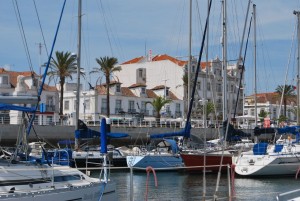

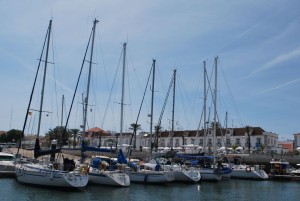
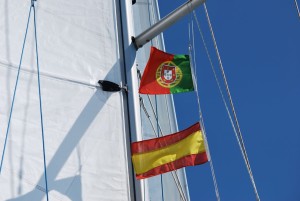
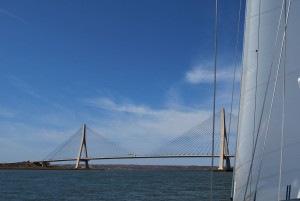
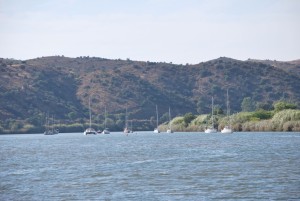
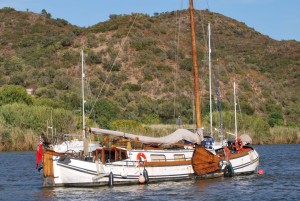
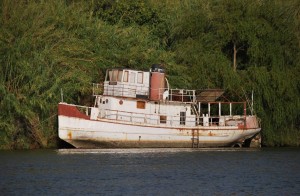
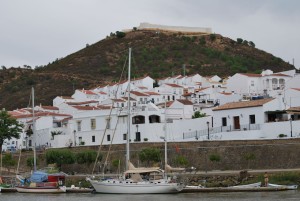
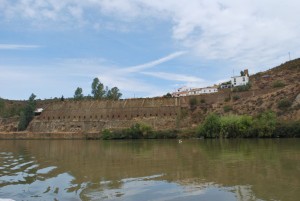

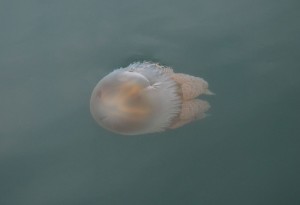
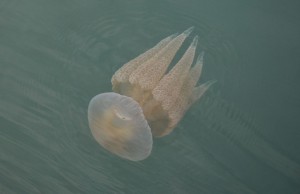
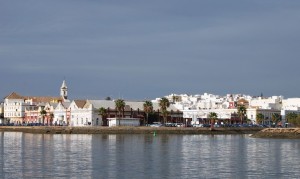
12 Comments
Judy
September 10, 2015 - 3:30 pmI can’t bear the suspense..please post the chapter about the fate of the jellyfish…
annie
September 10, 2015 - 6:45 pmWe will never know but I wouldn’t worry too much Judy. They are barrel jellyfish and appently have been washed up in huge numbers on the beaches of SW England, some as big as wheelie bins. Just when you thought it was safe to go back in the water. Annie x
Liz Billington
September 10, 2015 - 3:37 pmHow lovely – let out a big sigh as I sit at my hot desk reading your blog. Although the good news is I have a new part time job – hurrah. And on holiday in the south of France in 8 days time! Not going there are you? Lizx
annie
September 10, 2015 - 5:29 pmHi Liz. Congratulations on the job. No, we’re off further South after Gibraltar. To Morocco and the Canaries. Have a great time in the South of France. Annie x
Jim Lucas
September 10, 2015 - 9:36 pmGreat pictures – Did you enjoy Cadiz ? I went to Seville which I absolutely loved and they all said how nice Cadiz was. it looks interesting as a peninsula. What flavour jellies were they – it looks like vanilla
Annie
September 11, 2015 - 8:57 amHi Jim. We paid a flying (sailing?) visit to Cadiz and only had an afternoon to look around. Lovely, worth longer. Not sure I’d wish to speculate on the flavour of jellyfish, though if I was a leatherback turtle or bearded goby I’m sure I’d find them delicious, and I think that they are eaten in Asia. I read that they are massively on the increase in the oceans and a nuclear reactor in Sweden had to be shut down when they blocked the water intake pipes. Hugh is convinced that it was a Portuguese Man of War we saw washed up on the beach on the Isla de Culatra…. x
Sue Lucas
September 11, 2015 - 3:31 pmGreat pictures of jellyfish. They are a particular favourite of mine- unless I happen to be in the sea with them at the time. Loving your blog. X
annie
September 12, 2015 - 10:59 amThanks Sue. I agree – it makes me nervous of swimming in the sea, watching out for jellyfish all the time. Fine watching from the deck. xx
FM
November 7, 2015 - 11:44 amWe are on the Guadiana trying to figure out which fly to flag.
I say Portuguese because we come from Culatra and haven’t disembarked on the Spanish side and are across from Vila Real de S.A.
However, the chart shows we are anchored on the Spanish side.
With regard to your question: you can’t ever fly a sovereign nation’s flag below another because it indicates subsidiarity. So, can’t fly Port. flag below Spanish flag nor vice-versa.
Cheerio,
annie
November 9, 2015 - 9:59 amHi
Thanks for your comment. Let’s hope we didn’t upset too many Spaniards then!
Rosie
November 11, 2015 - 11:13 pmAt last have signed in to follow your blog; all very well set out and easy on the eye. Interesting to find my way around it and hope to be really familiar with it shortly. Don’t actually if you’ve started on the next leg; you did tell me when we met up but forget. Either way…… stay safe. x
annie
November 16, 2015 - 12:11 pmThanks Rosie. We’re off today! xx